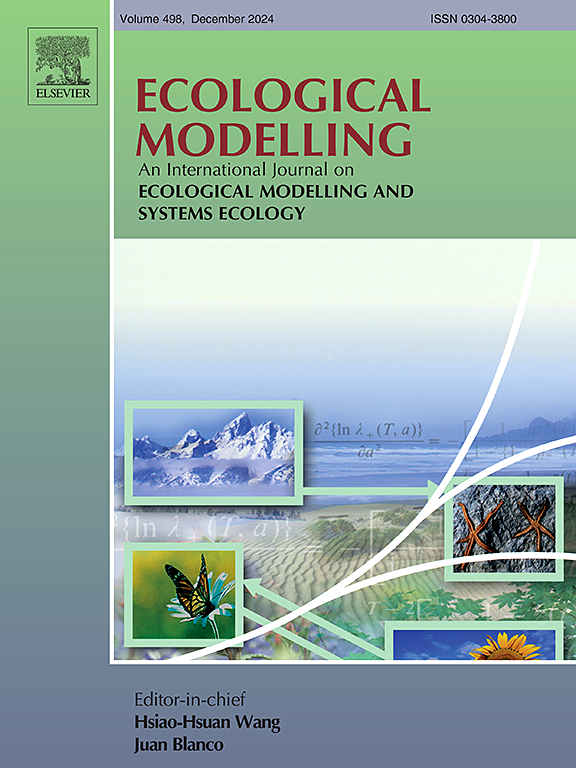A hierarchical population model for the estimation of latent prey abundance and demographic rates of a nomadic predator
IF 2.6
3区 环境科学与生态学
Q2 ECOLOGY
引用次数: 0
Abstract
Linking the demographic parameters underlying population change to environmental conditions is a central goal of population demography. However, multicollinearity among processes in ecological studies can complicate parameter estimation and inference. We sought to demonstrate the use of structural equation modelling, a technique for estimating hypothesized causal pathways among collinear observed and unobserved variables, in the context of integrated population models. We monitored a population of Tengmalm’s owls(Aegolius funereus) breeding in the Jura Mountains of northwestern Switzerland and eastern France for 31 years (1990-2020) and collected data on captured prey items. We use concepts central to structural equation models (i.e., latent variables) and integrated population models to estimate the effects of latent prey abundance on Tengmalm’s owl demographic parameters. We observed strong positive effects of latent prey abundance during time on clutch size, fledging probability, and immigration rates into the breeding population, and strong effects of positive changes in latent prey abundance from time to on first-year and adult survival. We also observed long-term declines in immigration into the study area. Our work provides a straightforward example of incorporating concepts central to structural equation models (e.g., latent variables) to model environmental processes underlying demographic rates in integrated population models, and has interesting implications for metapopulation ecology of Tengmalm’s owl populations in Europe.
一个用于估计潜在猎物丰度和游牧捕食者人口比率的分层种群模型
将人口变化背后的人口参数与环境条件联系起来是人口统计学的一个中心目标。然而,生态研究过程之间的多重共线性会使参数估计和推理复杂化。我们试图证明结构方程模型的使用,这是一种在综合人口模型背景下估计共线性观察和未观察变量之间假设因果通路的技术。我们对瑞士西北部和法国东部汝拉山脉的Tengmalm 's猫头鹰(Aegolius funereus)种群进行了31年(1990-2020年)的监测,并收集了捕获猎物的数据。我们使用结构方程模型的核心概念(即潜在变量)和综合种群模型来估计潜在猎物丰度对腾格玛猫头鹰人口统计参数的影响。我们观察到,在时间t期间,潜在猎物丰度对卵数、羽化概率和繁殖种群的迁移率有显著的正影响,并且从时间t到时间t+1期间,潜在猎物丰度的正变化对第一年和成虫存活率有显著的正影响。我们还观察到进入研究区域的移民数量长期下降。我们的工作提供了一个简单的例子,将结构方程模型的核心概念(例如,潜在变量)纳入综合种群模型中潜在人口比率的环境过程模型,并对欧洲Tengmalm猫头鹰种群的元种群生态学具有有趣的意义。
本文章由计算机程序翻译,如有差异,请以英文原文为准。
求助全文
约1分钟内获得全文
求助全文
来源期刊

Ecological Modelling
环境科学-生态学
CiteScore
5.60
自引率
6.50%
发文量
259
审稿时长
69 days
期刊介绍:
The journal is concerned with the use of mathematical models and systems analysis for the description of ecological processes and for the sustainable management of resources. Human activity and well-being are dependent on and integrated with the functioning of ecosystems and the services they provide. We aim to understand these basic ecosystem functions using mathematical and conceptual modelling, systems analysis, thermodynamics, computer simulations, and ecological theory. This leads to a preference for process-based models embedded in theory with explicit causative agents as opposed to strictly statistical or correlative descriptions. These modelling methods can be applied to a wide spectrum of issues ranging from basic ecology to human ecology to socio-ecological systems. The journal welcomes research articles, short communications, review articles, letters to the editor, book reviews, and other communications. The journal also supports the activities of the [International Society of Ecological Modelling (ISEM)](http://www.isemna.org/).
 求助内容:
求助内容: 应助结果提醒方式:
应助结果提醒方式:


